*If you are looking for a recommendation on the exact acoustic guitar to buy then head here
Introduction
Buying a guitar for the first time can be intimidating for the player who is just starting out. There are so many different kinds of guitars with lots of features, and price tags can swing from being as affordable as a pair of sunglasses up to the cost of a used car. It doesn’t help that the guy at the music store is using funny words like “intonation”, “
Buying your first acoustic guitar is made much simpler by learning just a few basic aspects of the instrument. Here in this guide, I will walk you through all the important points you need to know.
We will also go into deeper topics that will give you the knowledge you need to be absolutely confident in not only buying your first acoustic guitar, but for future purchases. These will include how to evaluate a guitar’s condition when buying second-hand, deciding whether to buy from a luthier or music store, and proper maintenance.
The Different Breeds of Acoustic Guitars
FLAT TOP / STEEL STRING
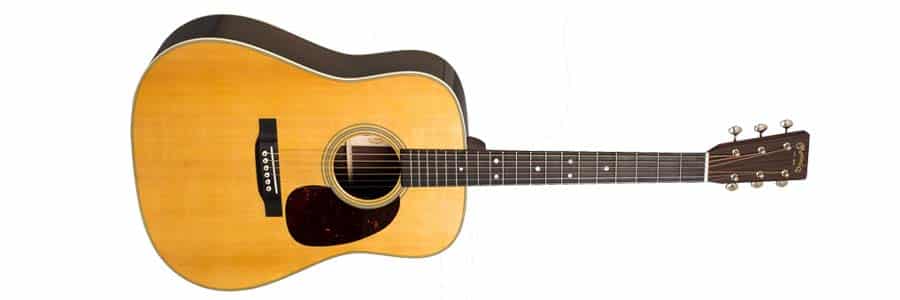
This is by far the most popular type of acoustic guitar. Chances are if you are listening to country, rock, or your favorite singer-songwriter, this is what you are hearing. This guitar features a flat top and back. These guitars are furnished with steel strings which is why they are often referred to simply as “steel-string” acoustics. These come in 12-string versions and a variety of different body types.
CLASSICAL:
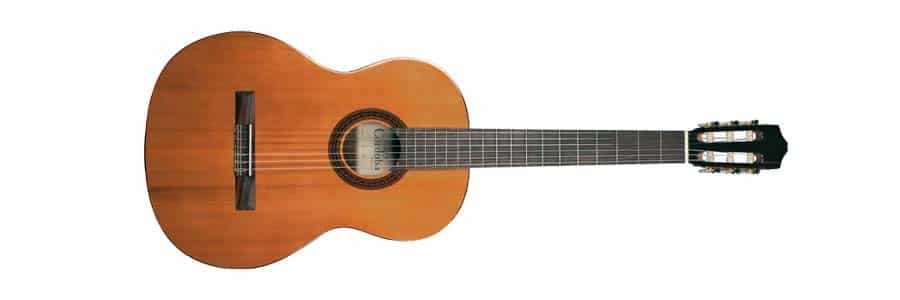
These guitars a staple in the fingerpicking stylings of classical, Spanish, and folk music. Classical acoustic guitars have a few differences from the typical flat top. Classical guitars have a smaller frame and have nylon strings, making them great student guitars. However, most classicals boast a noticeably thicker neck, presenting more of a challenge for the fretting hand.
ARCHTOP:
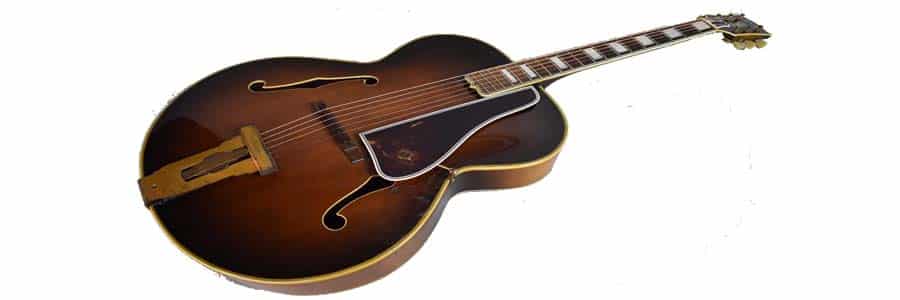
The archtop guitar, as its name suggests, has an arched top and back rather than being flat. Often these guitars have electronics in them for the purposes of amplification when playing live. The unique construction of these guitars gives it the sound that is typically featured in jazz, blues, and rockabilly.
RESONATOR:
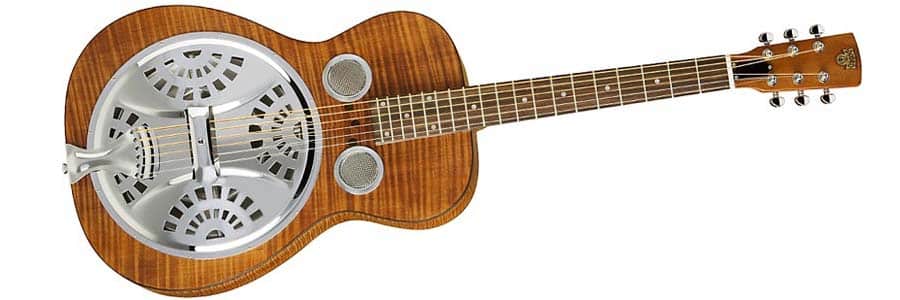
The
Resonators are oftentimes picked using the same finger picks that a banjo player would use, and paired with a slide around one of the fretting fingers. They can also be played with the guitar facing up rather than out with a tone bar used by the fretting hand. Some resophonic guitars have a square neck to sit on a lap or a stand, and an extra tall nut to raise the strings in order to accommodate the heavy stainless steel tone bar.
Anatomy Of The Guitar
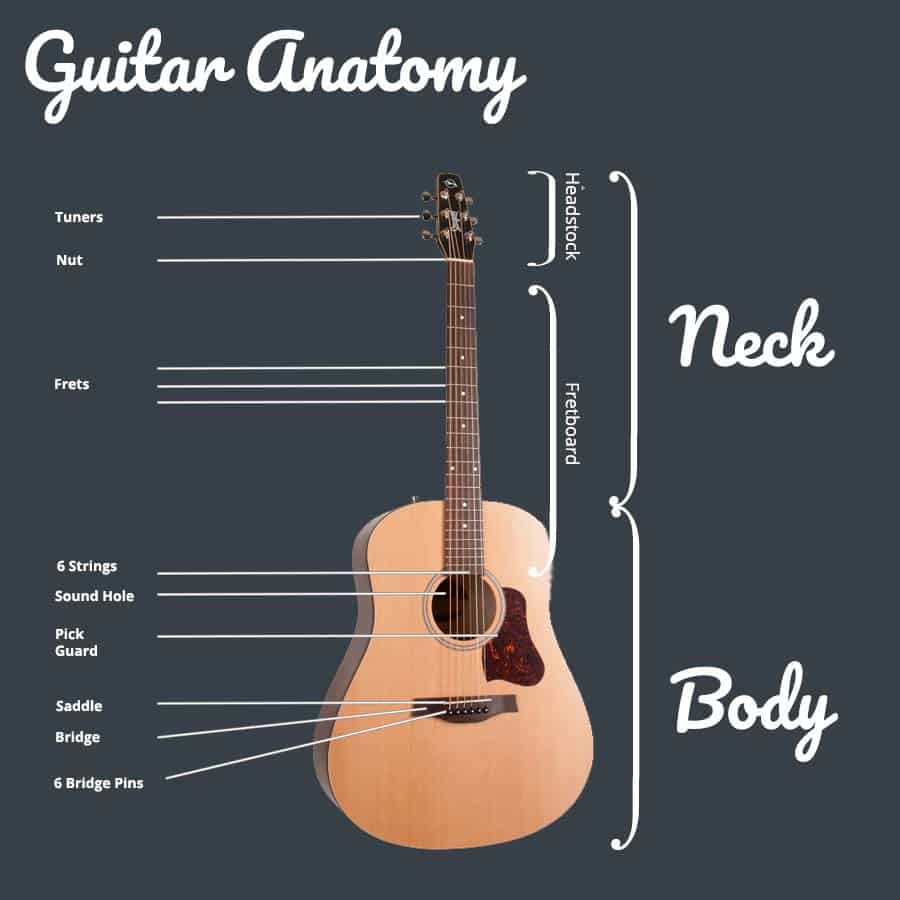
The guitar is much like a person. It has a body, neck, and a head or “headstock”
On the body of the guitar is the bridge where the strings are held in place with bridge pins. The strings sit on top of a strip of bone or plastic called the saddle. This is the primary place where the strings vibrate and produce sound. The sound comes out of the sound hole which is most often a simple round hold in the guitars top.
Some guitars will have F-holes such as the archtops, which is a style you see on something like a violin. Custom-built guitars may have sound holes in the side, or have a series of small holes in the top corner such as some Ovation guitars.
Below the sound hole is another piece that can change from guitar to guitar called the pick guard. These simply protect the guitar body from being scratched by the pick and don’t have anything to do with sound. Some guitars won’t even have them.
The guitar’s neck is where you will find the fretboard – a strip of wood that is glued on top of the neck and has pieces of metal wire installed into it called frets. When a string is pressed down on the fretboard, it comes to rest on a fret and creates a note.
Working your way up towards the head of the guitar, you will find another strip of bone or plastic that is notched to hold the strings in place called the nut.
Finally, the headstock is the part of the guitar that holds the tuners. Headstock designs will vary by manufacturer. The strings are wrapped tightly around the tuning posts or machine heads and the tuning keys are what adjust the pitch of each individual string.
Acoustic Guitar Tonewood

This is a huge topic where much research can be done. As a beginner, it’s good to know a little bit about the different woods that make up a guitar as that will aid in your quest to find the sounds you like best. Let’s look at some of the most popular and their basic tonal qualities.
• Spruce is the most popular wood for a guitar’s top. The pale wood is really the industry standard when it comes to guitar construction. It is considered to be a well-rounded wood with a good balance of brightness and warmth. It is a very common species of wood and readily available.
• Cedar is another popular choice for tops. It is more of a red-brown color and tends to be a little quieter than spruce due to having less density. Finger pickers usually prefer this wood and it is found on many classical guitars.
• Mahogany is most often used for the guitar’s back and sides, but it’s not unusual to find a guitar with a mahogany top. Mahogany is very warm in sound, being much less bright than spruce or cedar. It is regularly used in combination with a spruce top to add projection and a warm definition.
• Maple is also used for the back and sides of acoustic guitars. It has a much brighter quality than mahogany due to its density, and adds power when paired with a more typical top wood.
• Rosewood is one of the more expensive woods. The chocolate brown wood provides a very clear tone with rich, complex overtones. Brazilian rosewood is heavily regulated and difficult to procure. Indian rosewood is what you may come across more regularly. This wood is commonly used on fretboards due to its durability and texture.
• Ebony is a very dark wood which is more popular on electric guitar fretboards, but you do find a number of acoustic guitars using this wood. It has crisp, bright sound and its smoothness makes for a comfortable fretboard as well. This wood is generally left unfinished since it has a naturally oily quality.
• Walnut is not as common on fretboards, but is a good resilient wood similar to rosewood. Walnut is also bright in tone, but is balanced out with low-end frequencies. Walnut, ebony, and rosewood also make great bridge woods.
Size / Body Type
While there are many more sizes and body types beyond the standard flat top (ukuleles, classical, travel-size, harp guitars, etc.), the main focus as a first-time purchaser should be on the various types of steel-string flat top acoustic guitars.
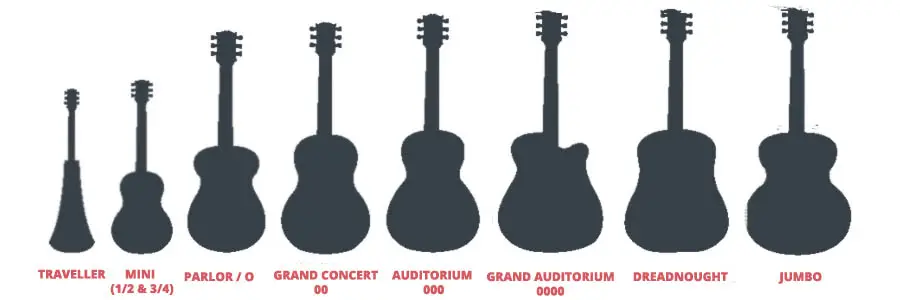
TRAVELLER / TRAVEL GUITAR:
A very small guitar with a body shaped like an elongated triangle and designed to be very portable and inexpensive while still being constructed of quality woods. They still have a full or nearly full-scale length.
EXTRA SMALL:
• ½ and ¾ size guitars: These miniature guitars are usually purchased for younger students until they grow into a full size guitar. They are much less expensive, but tend to be too small for the average adult to be comfortable. The sound is nothing to write home about, but keep in mind that these are generally temporary guitars.
• Parlor guitars are the smallest of the “full-size” guitar family. This is an older style of guitar that has seen a resurgence of late for people looking for that unique, nostalgic sound and look. These are referred to as “12 fret” models because the neck of these guitars most often joins the body of the guitar at the 12th fret.
SMALL:
• Concert guitars or “0” (read: single 0) are the next size up, but there are some manufacturers who do not differentiate between the 0 and the Parlor guitar. The main difference with some guitar makers is that a concert size will often have a neck that joins the body at the 14th fret rather the typical 12 fret parlor guitar, but there are 12-fret concert guitars as well.
• A Grand Concert – a 00 or “double 0” / “double aught” – is going to be a bit louder than the smaller single 0 guitar. Fingerpickers like these guitars because they get a good amount of volume out of them without having to play hard. However, they don’t get as loud as the bigger guitars when strummed with a heavy hand. In other words, these have a high floor and a low ceiling in terms of volume.
MEDIUM:
• Auditorium / 000 guitars are just a bit bigger and louder than the 00 but have a similar shape and still have a thin waist. Guitar maker Martin has a shape called a Grand Performance that can be considered a triple-0.
• Grand Auditorium / 0000 sizes are generally good for the all-around guitar player. Those who like to do both strumming and fingerpicking like these guitars for their volume levels with both techniques. They also tend to be more balanced with their high, mid, and low frequencies.
LARGE:
• Dreadnought guitars are everywhere. They are the most popular size, but can feel boxy for a person with a smaller frame. Dreadnoughts produce deep, booming bass sounds and play well when strummed loudly.
• Jumbos are the largest of the guitar models. These are big, loud, and boomy. They are also usually more expensive. Taylor, a popular guitar brand, will actually have a size that is somewhere between a Dreadnought and a Jumbo known as a Grand Orchestra which is their largest model.
With all of these different sizes, and the fact that many of the body shapes will vary from brand to brand, a first time guitar buyer should definitely spend some time in a brick-and-mortar music store to get a feel for them.
Trusted Guitar Name Brands & Prices
PC or Mac? Ford or Chevy? Xbox or PlayStation? Pretty soon, you’ll expect to be pulled into other loyalty conversations such as: “Martin or Gibson?” “Fender or Ibanez?” In my experience, name brand loyalty has never been as vitriolic in the guitar world as it is for the likes of Apple or Android, but people certainly do have their preferences.
Unlike rival operating systems or news outlets, most guitarists are equally pleased to own and play the Gibsons, Martins, and Taylors alike. The big concern you need to have is not necessarily which of the many well-known brands to go with, but rather which of the cheaper names to avoid. Here, we will look at the most popular and trusted guitar name brands. This is not an extensive list, but it will give you a great start.
C.F. Martin & Co. has been around since 1833. There is good reason for them being around since Andrew Jackson was running for his second term for the United States presidency. The quality of craftsmanship puts them way up on the guitar food chain. Up until 1916, most guitars were the smaller Spanish-style classicals. Martin changed all that by coming out with the Dreadnought. Martin guitars can fetch a price well into the thousands of dollars, but they have great lower-end models between the low $300s up to around $600.
This is another one of the big fish in the guitar pond. Since 1902, Gibson has been producing high quality acoustic and electric guitars alike. Originally a mandolin builder, Orville Gibson gained additional popularity after creating the first archtop guitar. They experienced a huge boost of fame in 1952 with the creation of the Les Paul electric guitar. Their acoustics, however, are some of the best around. In fact, the typical first timer is not to going to shell out the money for one of these. You’d be hard pressed to find one under $500. Most Gibson purchasers are prepared to spend around $1,000 or more. That why some people lean towards the less-expensive subsidiary, Epiphone.
Gibson was purchased by Chicago Musical Instrument Co. in 1944, then in 1957 CMI purchased Epiphone as well. Epiphone was originally founded in 1873 by a Greek luthier in modern-day Turkey. It took on the name Epiphone Banjo Company in the 1920s and began making their first guitars in 1928. After becoming a subsidiary of Gibson, many of its guitars were modeled after its former rival and are much more affordable. Their high quality and lower prices actually cut into Gibson’s sales! You can grab a good Epiphone between $200 and $400 easily.
Washburn started in 1883 in Chicago. In the 1920s Chicago became the hub for the Delta Blues and Washburn capitalized on this. Their guitars have been very popular with blues musicians, but are also loved by rockers. They have many quality guitar models to be had at around $200.
What don’t these guys make? The Japanese empire has been around since 1887 and makes everything from motorcycles to home theater systems to pianos. Not only do they have a huge line of products, especially in the instrument department, those products are renowned for their quality. They do make some good high-end guitars, but they really specialize in less expensive instruments in the $300 range.
Seagull is owned by Godin who
Founded in 1974, Taylor is among the younger guitar makers. Their top-shelf guitars are some of the best in the business, being played by the likes of Dave Matthews, Zac Brown, Jason Mraz, and many others. They do have some lower end and middle-of-the-road guitars in the $400 – $600 range, but the general consensus among my fellow guitarists is you are better off saving up for one of the $1000+ models.
Other Notable Names
If you have ever heard of this strange, six-stringed construct known as “the guitar”, chances are you’ve heard the name Fender. Although Fender is primarily known for their flagship Stratocaster and Telecaster models in the electric guitar arena, they do make quality acoustic guitars for very affordable prices.
A Japanese company who was one of the first to pioneer the acoustic-electric back in the late 70s, Takamine has great guitars in the middle of the price spectrum. You may be in a position to go ahead and get an acoustic-electric as your first guitar if you plan on performing in the very near future. I would recommend Takamine as one of your first to explore if that’s you.
Alvarez is among the more sought-after names in acoustic guitars for their 70s and 80s models, but there are very affordable beginner models out there at your neighborhood music store. This is another brand you really can’t go wrong with.
There are so many more good names out there. Guild, Breedlove, Blueridge. Many of these, however, will be more pertinent to you for future guitar purchases as they tend to be for the more serious and seasoned player.
What To Look For When Buying A Used or New Guitar
Technically, all of the guitars on the showroom floor are used. People come in and demo them all the time. Some stores like Guitar Center have very generous return policies and a guitar may have been returned more than once after spending a few weeks with a prior customer. Whether you are buying new or used, it’s good to know how to evaluate a guitar’s condition. This will give you incredible bargaining power and could save you from buying a lemon.
I have treated every guitar I have every bought as a used guitar and you should, too. Bargaining with a sales associate at a guitar store is easier than haggling with a car salesman. These guys largely work on commission and want you to buy the guitar more than you do! So take your time, listen to the guitar, see how it feels to your hands, and just inspect the thing.
Most stores will have a qualified tech on staff to handle any issues you have with the guitar before you leave. In fact, it’s good just to have that repair guy give the guitar a good once-over in your presence. You want him or her to check the intonation and the action (string height). They will usually do this for you for free since they want you to go home with it!
If you can, please bring someone you know who plays guitar when going guitar hunting. They will know exactly what to look for and be a second set of eyes and ears.
If you are buying from another owner from a local ad or Craigslist, knowing just a few basic things to look for will give you negotiating power so you can knock down the price in order to pay a luthier to fix any issues. This is a more advanced approach so if you are a beginner, I recommend doing plenty of additional research if this is the path that you are taking. Here’s some basic info on evaluating a guitar’s condition:
SIGHT THE NECK
With the guitar in playing position (meaning the guitar’s top is facing out like it would be played), approach the guitar from the headstock and look down the length of the neck. You want the neck to look straight or have a very slight forward bow.
As a beginner, you probably won’t know how much forward bow is appropriate, so I recommend you look for a straight neck, which is what most players prefer any way. But if it has a little bit of a forward curve, that’s okay as it is commonplace for manufacturers to set the guitar up this way.
This is the main factor that affects how high the strings are from the neck on an acoustic guitar. This string height is what is known as the “action”. The higher the action, the harder is to fret the strings. But if there is any back-bow, the strings will be too low and create buzzing.
CHECK THE INTONATION
Intonation is the guitar’s ability to play in tune. This is where you need a more experienced friend or know a few chords yourself so you can test this. First of all, the tuners on the headstock need to be firm, but smooth, and the strings should be able to be tuned to pitch with ease.
Next, play a few chords and few single notes along the string. If the strings themselves are in tune, but a chord sounds off, then something is wrong and it needs an adjustment.
These two things – intonation and action – are the main aspects of what is called a “setup”. If you are buying second-hand, then either have the store fix it for you or ask the guy from Craigslist to come down on the price at least $50 or $60 as that is the typical cost of an acoustic setup.
LOOK AT THE FRETS
Are the frets deeply pitted with string impressions in them? Do they look worn or flat on top as opposed to nice and round? Did you find a fretted note that doesn’t even really make a sound? This is especially important to evaluate when buying a guitar you know to be used. If you are a beginner buying your first guitar make sure the frets are nice and shiny, round, and free of dents. Otherwise, walk away.
Where To Buy Your Guitar
Buy From a Luthier, a Music Store or Online?
This question comes up a lot. Should you bother with a music store or just go straight to a luthier? If you go to a store, do you go to the mom-and-pop place down the street or to a big chain? These are fair questions so let’s examine your buying options.
LUTHIER:
The word “luthier” comes from the word “lute” and denotes someone who makes stringed instruments such as violins, guitars, mandolins, etc. If you are buying straight from a luthier, congratulations! You have the money and the knowhow to craft a custom guitar that fits your every desire.
But in all seriousness, luthiers generally make custom-built guitars to order and can take several months to churn out a single guitar. Some will build a small batch of handmade guitars from a template they have designed. Either way, this is the most expensive way to buy a guitar and not generally a path taken by a novice musician.
However, these are great people to be in relationship with as they are the real heroes to guitar owners. They can evaluate guitars for you if you are thinking of buying used and they will help you keep your guitar in great shape years down the road. They are usually the biggest of all guitar geeks and will be all too eager to teach you how to properly take care of your instrument. More on that later!
MUSIC SHOP:
You might have a locally-owned music store in your area that not only does instrument sales, but lessons. These tend to be the best in terms of customer experience as they are staffed with knowledgeable musicians who do not work on commission or answer to a bigger corporate entity. They will usually have the heart of a teacher rather than a salesman, and will work with you to make sure you get what you need.
MUSIC STORE CHAINS:
Big behemoths like Guitar Center and Sam Ash are very convenient and you can usually get the best deal when buying a guitar. The upside is if you know what you’re looking for and you can speak the lingo even a little bit, you can negotiate a good price or take advantage of promotional sales. The downside is you are just a number to them.
You may get lucky and get one of the good guys who is actually interested in serving you. However, you may also get the slimy salesman who tries to sound like they know more than they really do so that you buy as much extra stuff as they can shove down your throat. Places like this are notorious for their obnoxious pitch to sell you that “extended protection policy” when your guitar inevitably spontaneously bursts into flames.
As long as you do research prior to walking into any kind of music store and you are good at assertively saying, “No!” to the question, “Are you sure you don’t want the extended warranty for only $60??”, then you should be just fine.
ONLINE:
Buying online is fine if you know the guitar you are buying and have played it in store, at the very least you should have researched what is and isn’t a good guitar. Hopefully this guide has given you a good insight in to what you should be looking for.
I have personally played hundreds of acoustic guitars over the years and I unequivocally know what guitar I would recommend to a committed beginner. If you want to know what this then go here but whatever you do make sure to take time to try the instrument out.
***BUYER***BEWARE***
For the sake of your sanity, please avoid any guitar bought from a big-box, non-music store. A guitar from Costco, Wal-Mart, Target, or Toys-R-Us (R.I.P.), is nothing but a toy. My typical advice to a student is if you find a guitar under $100, be cautious. If you find a guitar under $50, alarms should be sounding. If you Google the brand of guitar and it doesn’t turn up much info… flee!
Accessories You Need
If you have foregone the online world then you will be
Just when you thought you were out of the woods, you are lost all over again. You have the guitar! What more could you possibly need?!
CASE:
You will need to buy a case with your guitar at the store on the same day. You
Your guitar needs to be protected, so this is important. Even if you get a cheap or free gig bag, it’s better than nothing. At most stores, you can negotiate the price and you will often get a significant discount on a good case when you buy a guitar.
TUNER:
You’ll want one of these. If you can’t tune your guitar, you will sound terrible forever so this is a must. You don’t need a tuner with a ton of bells and whistles. There are even tuners in the shape and size of a guitar pick that shine a laser on the strings to tell you whether or not the string is in tune. Cool! Useless.
You need a simple, chromatic tuner. In other words, a tuner that can tell the difference between a G and a G#. This will ensure accuracy when tuning since the tuner is calibrated to “hear” all of the notes, not just a select few.
The good news here is that you DON’T need to buy it at the music store! There are many free apps for your
(like Guitar Tuna) or dirt cheap that work just as well. When you are on stage it’s a different story, but as a
METRONOME:
As a long time instructor who has also been performing for many years and spent many hours in the studio, I have come to realize the importance of practicing with a metronome as early and as often as you can. These will help you develop your rhythm and make you a better musician faster than not using one at all. Many metronomes come built into electronic guitar tuners and they are also available as apps for your phone or tablet for free.
STRINGS:
The schedule for changing strings really depends on how much the guitar is played, but for the beginner, it’s recommended to change strings about once per month. I recommend having a set on hand, or buying some singles for the highest two or three strings in case you break one. If you don’t know how to change a string, your instructor can do it for you or your repairman at a local shop. I suggest you learn to do this on your own to save time and money.
For our purposes here, we won’t do a rundown of all the different guitar string manufacturers out there. The industry standard is D’addario at almost every repair shop, and they are very affordable. Ernie Ball, Martin, Dean Markley, and GHS are also trusted brands. Elixirs (coated strings – good for acidic fingers)are about three times the price of normal
PICKS:
They are good to have, so make sure you walk out with some. If you are a beginner just make sure to get some that are thin, .38 to .46mm thickness.
CAPO:
It is worth buying one of these at the start. You wont need it straight away but if you are following the justinguitar beginner course (Excellent free course) then you will find that you need this when you start to learn a few beginner songs. We reviewed the 3 best capos here so have a look if you want a recommendation.
Accessories You DO NOT need straight away:
Here’s a quick list of things you DON’T need to buy, at least not right away.
• Strap or extra strap buttons
• Multi tool or tool kit
• An acoustic-electric, pickup, or instrument cable unless you plan on performing on stage within a few months
• Foot stool
• ATA Flight case
• Effects / Processors
• Books
• Extended warranty or coverage (I could write an entire separate article on the foolishness of extended warranties)
• Finger exercisers
• Cleaning supplies
• Amplifier
• Replacement bridge pins
• Finger picks
Recommendation On What You Need In Your First Guitar Package
These are what I recommend buying / downloading as a beginner when your first start:
- A recommended guitar from a proven brand
- Ask for light gauge strings (11 gauge will be fine) to be installed before taking home your guitar or buy a spare set and learn to do it yourself.
- Buy a hard case with your new guitar purchase
- Picks – Get a few between .38mm and .46mm – thin ones are best when starting to learn.
- Capo
- Download a free guitar tuner and metronome app on your phone.
- Go the Justin Guitar beginner course and start learning
Do not buy a cheap laminated guitar, the likelihood is that the action will be high the intonation will be poor and the frustrations you have trying to make it work will put you off.
The best guitars are those that make you want to pick them up. Building a habit when you are learning is essential, once you have that then experience will follow.
The guitar I recommend comes with a hard case and it is a hard top which comes from a proven brand and is an all-around fantastic guitar, it costs more than a cheap beginner guitar but you won’t go wrong with it. Even if you have to sell, it will hold the majority of its value.
Basic Care and Maintenance
A guitar is an investment in a sense. It doesn’t go down in value like a car does the minute you leave the dealer. If you keep a guitar in good shape, it will retain its value and it will just get better with age. The key to this is taking good care of your guitar, so remember these important tips:
KEEP IT CLEAN
Hands are oily and acidic. They corrode strings, build up gunk on a guitar neck, and damage finishes. It’s a good idea to wipe down the strings and fretboard after each playing session using a
A few scratches or scuffs in the body won’t really do anything to the playability of the guitar, but it is good to keep unwanted dirt and moisture from getting into the wood to avoid cracking or unsightly bubbles in the laquer.
AVOID EXTREME ENVIRONMENTS
Subjecting a guitar to extreme changes in temperature or humidity can be detrimental. Leaving a guitar in a hot car or in the shed overnight in sub-freezing temperatures will cause damage over time. Carrying it without a case in the London rain or letting it sit on a porch for days on end in Arizona are not good practices.
Wood expands and contracts, it swells with moisture and it dries out. Big fluctuations will cause issues with every aspect of the guitar, particularly with the neck, body, and bridge. Neglected and abused guitars will get cracks in the body, have their bridge come unglued, have the truss rod in the neck seize up with rust, end up with warped tops, and a host of other problems.
When you are not playing the guitar, the best thing to do is to keep it in the case in the relatively stable atmosphere of a home or office.
TAKE IT IN FOR REGULAR CHECK-UPS
If you really like your guitar and you want it to play well for a long time to come, it will need a setup from time to time. The regularity of these shop visits will depend on your climate and the playing conditions your guitar is subject to.
For example, I live in a region that experiences all four seasons with hot, humid summers and cold, dry winters. I also play in excess of 20 hours per week. My guitars need a little adjustment at least once per year, but the ones I play the most may need to be tweaked every few months with a neck and/or intonation adjustment. The
Conclusion
Buying your first acoustic guitar does not have to be a big undertaking. There’s no need to be intimidated by the number of shapes, sizes, styles, or brands. At the end of the day, what matters most is how the guitar feels and sounds to YOU!
As you get more acquainted with the instrument and eventually look to upgrade to your second guitar, your love and knowledge will only grow. As it is with music, you will never stop learning about guitars and all the other little bells and whistles that go with them.
If you find yourself discouraged in your playing or think you are somehow unworthy when you step foot inside a music store, just remember this old, famous quote often ascribed to Robert Fulghum:
“Never forget that music is too important to be left entirely in the hands of professionals.”
Robert Fulghum
